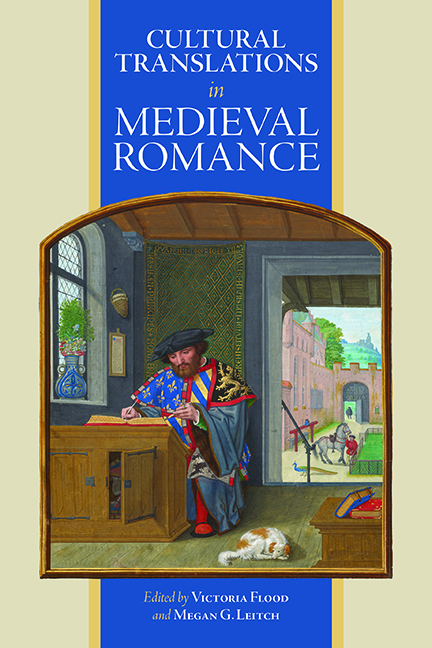Book contents
- Frontmatter
- Contents
- List of Contributors
- List of Abbreviations
- Introduction Insular Romance in Translation: New Approaches
- 1 Romantic Wales: Imagining Wales in Medieval Insular Romance
- 2 ‘Something remains which is not open to my understanding’: Enigmatic Marvels in Welsh Otherworld Narratives and Latin Arthurian Romance
- 3 The Supernatural Company in Cultural Translation: Dafydd ap Gwilym and the Roman de la Rose Tradition
- 4 Women and Werewolves: William of Palerne in Three Cultures
- 5 ‘Better a valiant squire than a cowardly knight’: Gender in Guruns strengleikr (The Lay of Gurun)
- 6 ‘Vinegar upon Nitre’? Walter Map’s Romance of ‘Sadius and Galo’
- 7 The Three Barriers to Closure in Hue de Rotelande’s Ipomedon and the Middle English Translations
- 8 Trojan Trash? The Seege or Batayle of Troye and the Learning of ‘Popular’ Romance
- 9 Poaching Romance: Fan Fiction Theory and Shared Medieval Narratives
- 10 Between Epic and Romance: The Matter of England and the Chansons de Geste
- 11 Geographies of Loss: Cilician Armenia and the Prose Romance of Melusine
- 12 ‘All this will not comfort me’: Romancing the Ballad in The Squire of Low Degree
- 13 Merchants in Shining Armour: Chivalrous Interventions and Social Mobility in Late Middle English Romance
- Index of Manuscripts
- General Index
- Miscellaneous Endmatter
4 - Women and Werewolves: William of Palerne in Three Cultures
Published online by Cambridge University Press: 07 October 2022
- Frontmatter
- Contents
- List of Contributors
- List of Abbreviations
- Introduction Insular Romance in Translation: New Approaches
- 1 Romantic Wales: Imagining Wales in Medieval Insular Romance
- 2 ‘Something remains which is not open to my understanding’: Enigmatic Marvels in Welsh Otherworld Narratives and Latin Arthurian Romance
- 3 The Supernatural Company in Cultural Translation: Dafydd ap Gwilym and the Roman de la Rose Tradition
- 4 Women and Werewolves: William of Palerne in Three Cultures
- 5 ‘Better a valiant squire than a cowardly knight’: Gender in Guruns strengleikr (The Lay of Gurun)
- 6 ‘Vinegar upon Nitre’? Walter Map’s Romance of ‘Sadius and Galo’
- 7 The Three Barriers to Closure in Hue de Rotelande’s Ipomedon and the Middle English Translations
- 8 Trojan Trash? The Seege or Batayle of Troye and the Learning of ‘Popular’ Romance
- 9 Poaching Romance: Fan Fiction Theory and Shared Medieval Narratives
- 10 Between Epic and Romance: The Matter of England and the Chansons de Geste
- 11 Geographies of Loss: Cilician Armenia and the Prose Romance of Melusine
- 12 ‘All this will not comfort me’: Romancing the Ballad in The Squire of Low Degree
- 13 Merchants in Shining Armour: Chivalrous Interventions and Social Mobility in Late Middle English Romance
- Index of Manuscripts
- General Index
- Miscellaneous Endmatter
Summary
William of Palerne, otherwise known more engagingly as William and the Werewolf, survives in Middle English in only one manuscript, but it was much more widely known than that would suggest. The romance was originally composed in continental French in the late twelfth or early thirteenth century, for a ‘countess Yolande’, probably a countess of Hainault who died c. 1212. The mid-fourteenth-century Middle English translation – and despite its chosen form of alliterative rather than rhymed verse, it frequently comes closer to being a translation than the kind of free adaptation made of many French or Anglo-Norman romances into English – was composed, as the translator (himself called William) tells us, for a grandson of Edward I, Humphrey de Bohun, sixth earl of Hereford, who died in 1361. Both these versions, the French and the English, were printed in prose renderings in the sixteenth century. The French prose, based on the original Guillaume, was produced some time before 1535, and went through a number of editions into the seventeenth century. It was preceded by the English prose, printed around 1515 by Wynkyn de Worde complete with woodcuts. This survives in the form of only two leaves from near the end of the story, though that is sufficient to demonstrate that, exceptionally among prose romances, it was based on the Middle English poem, not on any French version. Those leaves are also enough to show that it was the immediate source of the Irish Eachtra Uilliam, ‘the deeds of William’ (or, as one might put it in a more medieval formulation, the Gesta Guilielmi). It was composed probably towards the end of the sixteenth century for the high-ranking Anglo-Irish Dillon family of county Mayo. This version too is predominantly in prose but, like many Irish romances, it also contains a number of inset lais such as are recurrently found in other Irish romances, but apparently never elsewhere in one translated from another language. All of these, except for the French prose, survive in only a single copy. The rest of this chapter will focus primarily on three of those various texts, the octosyllabic French, the alliterative English, and the prose with interspersed verse of the Irish; but, taken together with the printed prose versions, they indicate how attractive the story was found across a range of cultures, languages, and prosodic forms into the early modern period.
- Type
- Chapter
- Information
- Cultural Translations in Medieval Romance , pp. 85 - 100Publisher: Boydell & BrewerPrint publication year: 2022



